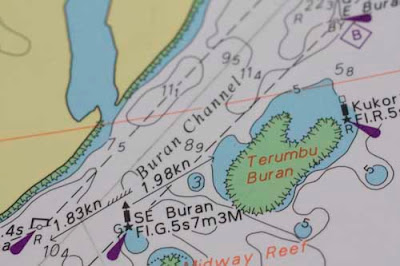Two Hooded Pittas Pitta sordiad cucullata were spotted at the Singapore Botanic Gardens, which is a great finding. Winter visitor. The Hooded ldiet consist of mainly insects but may feed on other organism too. Poh Bee manage to take a photo of it feeding on land snail. Here's a link to a online article on Pittas of Singapore by A. F. S. L. Lok, K. T. N. Khor, K. C. Lim and R. Subaraj.
Tanjung piai - Johor National Park
This is the bridge that leads us to the visitor centre, admission ticket its RM 5 for student and RM 10 for adults.
What a nice visitor centre!
Very infomative!
And BIG labels....
And the hide.
As usual, there are still alot of Mangrove Skink Emoia atrocostata . Hard to find them in Singapore even at Sungei Buloh Wetland Reserve.
We saw a female Common flameback Dinopium javanense. Here's a photo of a male common flameback which is taken at Sungei Buloh on my flickr.
A pair of helmet snail.
Gold-spotted mudskipper Periophthalmus chrysospilos
To reach the southern most tip of Mainland Asia, we had to cross a flooded pavement.
Lined nerite snail Nerita articulata
The best sighting, dusky leaf monkey, which i din get to see it during my last visit!
Hunt for the Grey Plover
My first record shot of the Grey Plover (Pluvialis squatarola). It's just too far away for my 400mm lens to reach! Got to heavily crop it. Before i got the Grey plover there are some of the birds that i bump into:
The Common Flameback is one of our common resident woodpecker.
Not to miss out the Red Tent Spider.
Landing at Terumbu Buran
We departed from ONE°15 Marina Club which is located at sentosa cove. Look at the beautiful yacht!
It's interesting to look the navigation stuff on the boat
This small land/rocks (whatever you call it) or called Terumbu is located not far away from mainland Singapore. It is only 10mins boat ride from Sentosa. We took a longer time because this is to make sure that we find a right place which is safe the our boat to anchor and less choppy waves!
There are quite a few Oval sea grapes, they are actually a type of seaweed. Sea grapes are eaten in Philippines as salad or can be eaten later if preserved in salt.
And many nice looking red sea weed.
Of cause not to miss out the hard corals.
Many zoanthid too.
Orange fan worm! Too bad i only saw one. More photos on orange fan worm on Ria's site
I walked into a small area which is between two tall rocks hoping to find something interesting. As i was walking with caution because i do not want to step onto any stonefish. This Two-spot reef octopus caught my attention as it is changing its colour. I guess it feels threaten of my presence there.
Lets have a closer look at the 'suckers'.
Look at the Hairy crab! Its really covered with hair. This is one of the fascinating crab that i was when i started on marine stuff. I guess the first hairy crab that i saw was at P. Semakau with Raffles Museum as a 'part-time/unofficial' project semakau volunteer.
The pincer of the Red eyed stone crab (Eriphia ferox) !
And i'm still ALIVE after this adventurous trip! hahah! Photos taken during this trip are from Nikon 55mm f/3.5 Micro lens (Thanks weixiang for lending his lens, I had a hard time trying to focus haha) on a Canon 450D body.
More Photos on my Flickr
Jackfruit (Artocarpus heterophyllus)
Native to southeast asia and seen at kampong areas in singapore, the Jackfruit tree produces one of the largest tree-borne fruit in the world and can weight up to 36kg! The fruits are not only eaten raw but can be also eaten many forms: Canned in syrup, dried (jackfruit chips), fried, cooked in curry and many more.
The wood of the tree is used to make musical instruments in Indonesia.
Subscribe to:
Comments (Atom)


















































